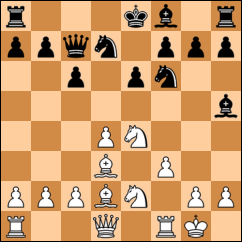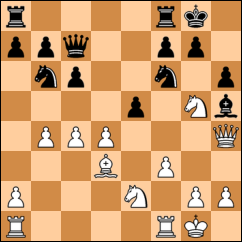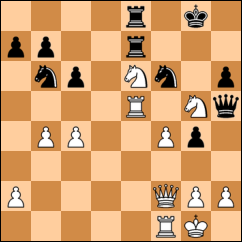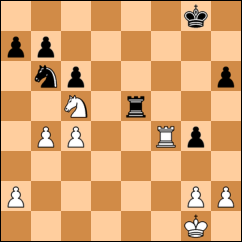Thursday 21 January 2016
White: K. Nevols - Black: D Harvey (147)
This time our Hastings counterparts made the journey north up to our way - not a bad feat considering they did it on a dark winter's evening
1. e4 e5
2. Nf3 Nc6
3. Bb5
The Ruy Lopez. I've decided to ditch the Guioco Piano and go back to an opening I know something about.
3. .... Bc5
This is known as the Classical Defence (or Cordel Defence). Apparently 4. c3 is the most common reply when Black could go for 4. ... f5 (the Cordel Gambit) or the more solid 4. . Nf6.
White's 4th move alternatives are 4. O-O or even 4. Nxe5.
Not knowing this I decided just to act solid but lose a tempo in the opening.
4. d3 Nge7
5. O-O d6
6. c3 O-O
7. d4
Missing the tempo but d4 has to be done in the Ruy.
7. ... exd4
8. cxd4 Bb6
9. h3
Another standard Ruy move to avoid the knight getting pinned.
9. ... Bd7
10. Nc3 Ng6
The knight looks slightly out of place here so I try to think up some ideas of a kingside attack.
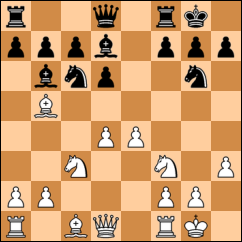
11. Bg5 f6
12. Bc4+ Kh8
13. Be3
Defending the d4 point.
13. .... Qe8
The computer thinks I now have a clear advantage (0.5) and suggests a number of ways of consolidating with a3, Rc1, Re1, Qe2 preparing d5 or Qc2 thinking about Nd5.
14. Kh1
I had given some thought to 14. h4 but Black simply has 14. ... Bg4. Instead the point of this move is to make space for the knight to retreat so I can get f4 in. (I can't retreat the knight to d2 as then the d4 pawn hangs).
14. ... Nce7
15. Ng1?
Wasting time with the knight gives away all of the advantage. Just calmly gaining space with 15. a3 or 15. Re1 is better.
15. ... f5!
But Black counters first. This move put me off balance. If now 16. f4 then fxe4 17. Nxe4 Nf5 18. Qd3 Qxe4! winning a piece. 16. exf5 Nxf5 looks ugly but is probably better than the text. I did not like the idea of all those pieces heading towards my king. 16. exf5 is better than the move I played.
Another idea is 16. f3 with a possible line being 16. .. fxe4 17. fxe4 Rxf1 18. Qxf1 Ne5!?
16. Nf3?!
Instead I decided to waste more time and aim for the g5 square.
16. ... fxe4
If now 17. Nxe4 then simply d5.
17. Ng5?
I am now threatening Nxh7 which Black cannot retake Kxh7 because of Qh5 mate. The plan is to retake the pawn with this knight after 17. ... h6.
17. .... Nf4
For some reason I had completely overlooked this move. I now can't retake on e4 as if 18. Ngxe4 then 18... d5.
(One line is 19. Bxf4 Rxf4 20. g3 Rxe4 21. Nxe4 dxc4 which would leave Black with two bishops for the rook - or 20 ... Bxh3 with a choice of 21. Rf1 Bg4! with Qh5 to come or 21. gxf4 Bxf1 22. Qxf1 dxe4 23. Nxe4 Bxd4 and Black is a pawn up).
Now 18. Bxf4 Rxf4 19. Nf7+ is an idea to try to make the position clearer. Then 19. .. Rxf7 20. Bxf7 Qxf7 21. Nxe4 Bc6. Material is even but the position looks uncomfortable.
(The computer recommends a bit of grovelling with 18. Qd2 d5 19. Bb3 Nd3 20. Nxd5).
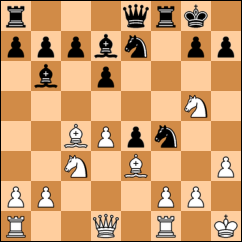
18. d5
Instead, after much thought, I decided to isolate the e-pawn to pick it up later. Black now has the initiative.
18. .... Qg6
19. Bxf4 Rxf4
20. Ngxe4
Better (although not by much) is 20. g3. Now Black has the option of taking both knights for the rook but plays more conservative with his attack.
20. ..... Qh6
21. Qd3 Raf8
22. Ne2 Rf3!!
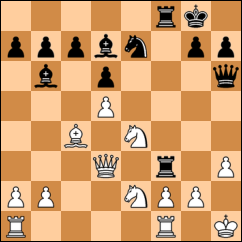
While he was thinking, I too was thinking over whether Black could play this. I could not see anything concrete and figured that, as he had the better position anyway, it was not worth it taking chances. (Going through the position afterwards, I see that this now wins by force).
23. gxf3 Qxh3+
24. Kg1 Rxf3
25. Qd1
A few moves later I was kicking myself for choosing the wrong square, as the bishop is undefended and gets picked up by the follow sequence. But 25. Qc2 loses to 25. ... Bf5.
25. ... Qg4+
26. N2g3 Rxg3+
27. Nxg3 Qxg3+
28. Kh1 Qh4+
29. Kg1 Qxc4
So Black has three minor pieces and two pawns against White's two rooks.
30. Qf3 Qg4+
31. Qxg4 Bxg4
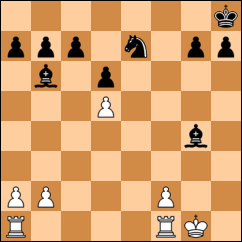
Now outnumbered on both sides of the board, with the d5 pawn seemingly a goner, I could see that a grim defence is in prospect. I could not see how I could defend this position but now surprise myself by putting up a bit of a fight. First, I limit the options for Black's white squared bishop.
32. Re1 Ng8
33. Kg2 h6
34. f3 Bd7
35. Rad1 Nf6
36. b3 Be8
37. Re7 Kg8
38. Re2 Bf7
39. Red2 Nd7
So far so good. The staunch defence of the d5 pawn holds up Black's initiative.
40. Kg3 Kf8
41. Re2 Nf6
42. Red2 Ke7
43. Re2+ Kd7
44. Red2 Bc5
45. Kg2
I haven't really got anything else to do.
45. ... c6
And Black gives up hope of winning the pawn and decides to swap it off. (45. ... Nh5 with Nf4 and Be3 will capture the d5 pawn).
46. dxc6+ bxc6
47. Rc2 Bd5
Good positioning of the bishops although in the way of the pawns.
48. Kg3 Bb6
49. Re1 Bf7
50. Rg2
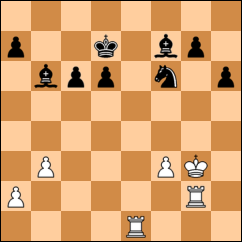
And now with less than five minutes left on my clock I stop writing down the moves. My opponent had a few extra minutes and invested some time on the moves ahead.
As the game progressed Black did manage to advance the c- and d-pawns. My rooks were buzzing to and fro trying to be a nuisance and avoiding several forks and pins while the pawns and pieces came closer, like a game of Space Invaders. I entered my last minute and began moving at lightning speed before blundering away a rook. With seconds left in a hopeless position, I resigned.
